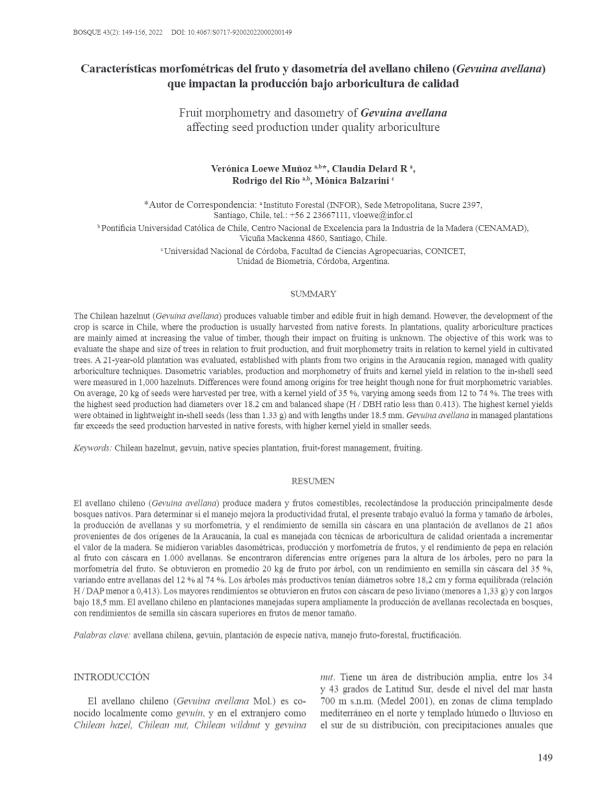Mostrar el registro sencillo del ítem
dc.contributor.author
Muñoz, Verónica Loewe
dc.contributor.author
Claudia, Delard R.
dc.contributor.author
Del Río, Rodrigo
dc.contributor.author
Balzarini, Monica Graciela

dc.date.available
2024-02-09T13:53:42Z
dc.date.issued
2023-02
dc.identifier.citation
Muñoz, Verónica Loewe; Claudia, Delard R.; Del Río, Rodrigo; Balzarini, Monica Graciela; Características morfométricas del fruto y dasometría del avellano chileno (Gevuina avellana) que impactan la producción bajo arboricultura de calidad; Universidad Austral de Chile; Bosque (Valdivia); 43; 2; 2-2023; 149-156
dc.identifier.issn
0304-8799
dc.identifier.uri
http://hdl.handle.net/11336/226604
dc.description.abstract
El avellano chileno (Gevuina avellana) produce madera y frutos comestibles, recolectándose la producción principalmente desde bosques nativos. Para determinar si el manejo mejora la productividad frutal, el presente trabajo evaluó la forma y tamaño de árboles, la producción de avellanas y su morfometría, y el rendimiento de semilla sin cáscara en una plantación de avellanos de 21 años provenientes de dos orígenes de la Araucanía, la cual es manejada con técnicas de arboricultura de calidad orientada a incrementar el valor de la madera. Se midieron variables dasométricas, producción y morfometría de frutos, y el rendimiento de pepa en relación al fruto con cáscara en 1.000 avellanas. Se encontraron diferencias entre orígenes para la altura de los árboles, pero no para la morfometría del fruto. Se obtuvieron en promedio 20 kg de fruto por árbol, con un rendimiento en semilla sin cáscara del 35 %, variando entre avellanas del 12 % al 74 %. Los árboles más productivos tenían diámetros sobre 18,2 cm y forma equilibrada (relación H / DAP menor a 0,413). Los mayores rendimientos se obtuvieron en frutos con cáscara de peso liviano (menores a 1,33 g) y con largos bajo 18,5 mm. El avellano chileno en plantaciones manejadas supera ampliamente la producción de avellanas recolectada en bosques, con rendimientos de semilla sin cáscara superiores en frutos de menor tamaño.
dc.description.abstract
The Chilean hazelnut (Gevuina avellana) produces valuable timber and edible fruit in high demand. However, the development of the crop is scarce in Chile, where the production is usually harvested from native forests. In plantations, quality arboriculture practices are mainly aimed at increasing the value of timber, though their impact on fruiting is unknown. The objective of this work was to evaluate the shape and size of trees in relation to fruit production, and fruit morphometry traits in relation to kernel yield in cultivated trees. A 21-year-old plantation was evaluated, established with plants from two origins in the Araucanía region, managed with quality arboriculture techniques. Dasometric variables, production and morphometry of fruits and kernel yield in relation to the in-shell seed were measured in 1,000 hazelnuts. Differences were found among origins for tree height though none for fruit morphometric variables. On average, 20 kg of seeds were harvested per tree, with a kernel yield of 35 %, varying among seeds from 12 to 74 %. The trees with the highest seed production had diameters over 18.2 cm and balanced shape (H / DBH ratio less than 0.413). The highest kernel yields were obtained in lightweight in-shell seeds (less than 1.33 g) and with lengths under 18.5 mm. Gevuina avellana in managed plantations far exceeds the seed production harvested in native forests, with higher kernel yield in smaller seeds.
dc.format
application/pdf
dc.language.iso
spa
dc.publisher
Universidad Austral de Chile

dc.rights
info:eu-repo/semantics/openAccess
dc.rights.uri
https://creativecommons.org/licenses/by-nc-sa/2.5/ar/
dc.subject
CHILEAN HAZELNUT
dc.subject
FRUIT-FOREST MANAGEMENT
dc.subject
FRUITING
dc.subject
GEVUIN
dc.subject
NATIVE SPECIES PLANTATION
dc.subject.classification
Silvicultura

dc.subject.classification
Agricultura, Silvicultura y Pesca

dc.subject.classification
CIENCIAS AGRÍCOLAS

dc.title
Características morfométricas del fruto y dasometría del avellano chileno (Gevuina avellana) que impactan la producción bajo arboricultura de calidad
dc.title
Fruit morphometry and dasometry of Gevuina avellana affecting seed production under quality arboriculture
dc.type
info:eu-repo/semantics/article
dc.type
info:ar-repo/semantics/artículo
dc.type
info:eu-repo/semantics/publishedVersion
dc.date.updated
2024-02-09T11:18:33Z
dc.identifier.eissn
0717-9200
dc.journal.volume
43
dc.journal.number
2
dc.journal.pagination
149-156
dc.journal.pais
Chile

dc.journal.ciudad
Valdivia
dc.description.fil
Fil: Muñoz, Verónica Loewe. Pontificia Universidad Católica de Chile; Chile. Instituto Forest Biblioteca; Chile
dc.description.fil
Fil: Claudia, Delard R.. Instituto Forest Biblioteca; Chile
dc.description.fil
Fil: Del Río, Rodrigo. Instituto Forest Biblioteca; Chile. Pontificia Universidad Católica de Chile; Chile
dc.description.fil
Fil: Balzarini, Monica Graciela. Instituto Nacional de Tecnología Agropecuaria. Centro de Investigaciones Agropecuarias. Unidad de Fitopatología y Modelización Agrícola - Consejo Nacional de Investigaciones Científicas y Técnicas. Centro Científico Tecnológico Conicet - Córdoba. Unidad de Fitopatología y Modelización Agrícola; Argentina
dc.journal.title
Bosque (Valdivia)

dc.relation.alternativeid
info:eu-repo/semantics/altIdentifier/doi/http://dx.doi.org/10.4067/S0717-92002022000200149
dc.relation.alternativeid
info:eu-repo/semantics/altIdentifier/url/https://www.scielo.cl/scielo.php?script=sci_arttext&pid=S0717-92002022000200149&lng=en&nrm=iso&tlng=en
Archivos asociados
